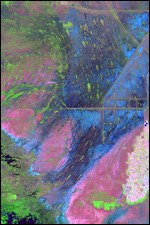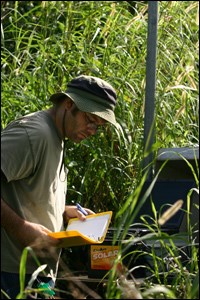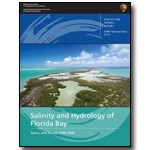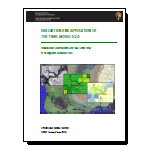|
"Here are no lofty peaks seeking the sky, no mighty glaciers or rushing streams wearing away the uplifted land. Here is land, tranquil in its quiet beauty, serving not as the source of water, but as the last receiver of it. To its natural abundance we owe the spectacular plant and animal life that distinguishes this place from all others in the country." President Harry S. Truman, address at the Dedication of Everglades National Park, December 6, 1947 
Map courtesy of U.S. Army Corps of Engineers The Greater Everglades were famously coined as The River of Grass by Marjory Stoneman Douglas as part of her efforts to call attention to the degradation of the south Florida ecosystem in 1947. Although authorized in 1934, Everglades National Park was not established until 1947, one month after the release of Douglas's book The Everglades: River of Grass. Everglades National Park protects a portion of the Greater Everglades, the largest freshwater marsh in the United States. A range of terrestrial, estuarine, and marine habitats simultaneously converge amidst a blend of temperate and subtropical climates to create the unique hydrologic conditions that exist in the Everglades. Water quantity and quality are critical to the health of the ecosystems that support the myriad plant and animal species inhabiting the park. However, a long history of water management in support of agricultural and urban development in south Florida has caused serious and continuing degradation of the Everglades ecosystem, prompting Congress to authorize the Comprehensive Everglades Restoration Plan (CERP) in 2000. The CERP was authorized by Congress in 2000 as a plan to "restore, preserve, and protect the South Florida ecosystem while providing for other water-related needs of the region, including water supply and flood protection." At a cost of more than $10.5 billion and with a 35+ year time-line, this is the largest hydrologic restoration project ever undertaken in the United States. Everglades National Park currently is involved in the Central Everglades Planning Project, a fast-track planning effort for the next generation that will, when authorized by Congress, improve the Central and Southern Everglades by putting more fresh and clean water into the River of Grass. 
Image courtesy of EvergladesPlan.org 
NPS photo Successful restoration of the Everglades ecosystem requires the appropriate interaction between the quantity, quality, timing, and distribution of water. As part of the Hydrologic Monitoring Program, park hydrologists monitor the condition of freshwater, brackish water, and salt water resources in the Everglades through an extensive network of hydrologic monitoring sites and stations. Collected data are analyzed to better understand the movement and condition of surface and groundwater resources. In addition, biologists and ecologists monitor and evaluate biological, chemical, and environmental factors that affect water quality, including contamination and pollution produced by human activity and by natural processes. Learn more about how the park monitors its estuarine and marine resources in the Florida Bay Monitoring Program. 
Salinity and Hydrology of Florida Bay: Status and Trends 1990-2009 
|
Last updated: May 31, 2021
